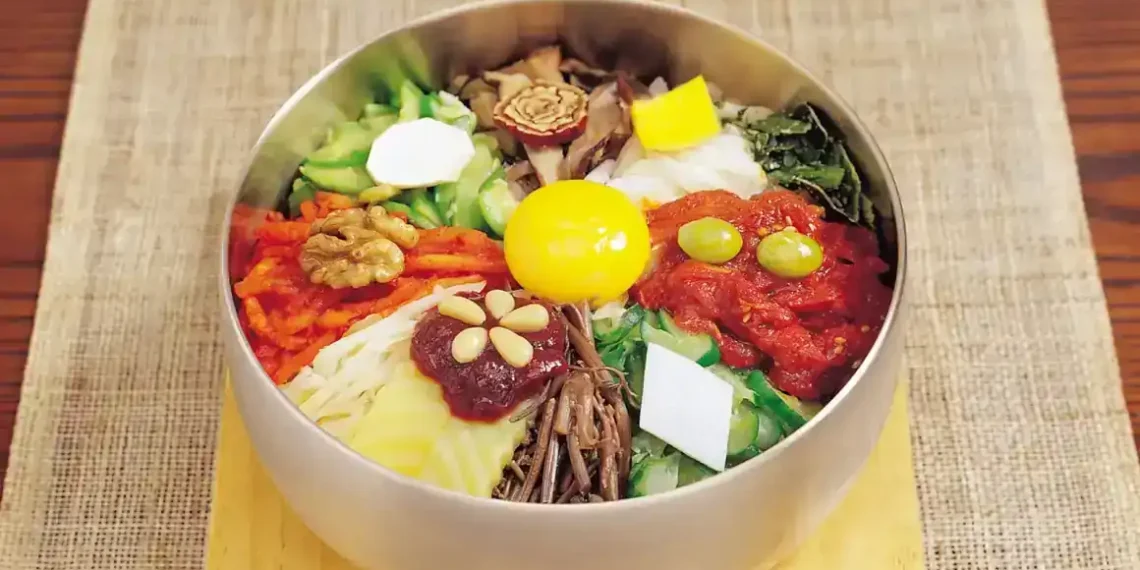More than 100 different types of kimchi are available in Korea, which speaks volumes about how much Koreans value their cuisine. Korean food has changed over time as a result of cultural shifts, but it continues to be a key component of the country’s identity.
Here are 40 dishes that are essential to the Korean heart, soul, and digestive tract.
Must-Try Korean Soups & Stews
Hangover Stew (해장국)
Given South Korea’s dedicated drinking culture, it’s not surprising that its hangover-curing culture is equally developed. From pre-drinking to post-drinking concoctions, there’s a glorious array of spicy and steamy stews and soups designed to revive you. This deeply satisfying beef broth, featuring cabbage, bean sprouts, radish, and chunks of congealed ox blood, does wonders to kick-start your sluggish brain in the morning.
Soft Tofu Stew (순두부찌개)
Soft tofu, clams, and an egg in a spicy broth? This popular stew is a classic example of unexpected flavor combinations yielding delightful sensations. The soft tofu, which breaks into fluffy chunks, absorbs the clam’s flavor and offers a welcome contrast to the overall spiciness. Authentic sundubu-jjigae is served in a traditional earthenware pot designed to retain heat, with the egg cracked into the stew after serving to cook in the residual warmth.
Kimchi Stew (김치찌개)
Kimchi’s versatility as an ingredient in a whole category of derivative dishes is a lesser-known fact. In kimchi-jjigae, red cabbage kimchi is chopped, sautéed in oil, and cooked with tofu, pork (sometimes tuna), and other vegetables. Despite the stew’s debt to kimchi, it truly comes into its own when served with kimchi as a side dish.
Army Stew (부대찌개)
This hodgepodge stew of sausages, Spam, American cheese, instant noodles, tteok (rice cakes), and assorted vegetables dates back to the aftermath of the Korean War. With meat being scarce, cooks creatively used surplus foods from the American army base in Seoul, giving the stew its name. While meat is now plentiful, budae jjigae without Spam is simply unimaginable.
Gamjatang (감자탕)
While “gamja” means potato in Korean, in this hearty dish, it refers to pork bone soup. Most gamjatang restaurants are open 24 hours, as South Koreans often crave this stew in the early hours as an alternative to hangover stew. This robust dish features potatoes (gamja), scallions, ground perilla seed, and bits of pork cooked in a rich pork bone broth. The real appeal lies in the unique taste of the perilla seed, perhaps even more crucial to the flavor than the meat itself.
Ox Bone Soup (설렁탕)
Easily recognizable by its milky white color and sparse ingredients, seolleongtang broth typically contains noodles, finely chopped scallions, and a few strips of meat. Yet, for such a simple investment, the results are incredibly rewarding. There’s nothing quite like a steaming bowl of seolleongtang on a cold winter day, salted and peppered to your taste, and complemented by nothing more than rice and kkakdugi kimchi.
Tteokguk (떡국)
Originally, tteokguk was strictly eaten on the first day of the Lunar New Year to signify good luck and the gaining of another year in age—idiomatically expressed as “eating another year.” However, this dish of oval rice cake slices, egg, dried laver seaweed, and occasionally dumplings in a meat-based broth is now enjoyed year-round, regardless of age or season.
Doenjang Jjigae (된장찌개)
This humble, instantly recognizable stew is one of Korea’s most beloved comfort foods. The ingredients are simple: doenjang (fermented soybean paste), tofu, mushrooms, green peppers, scallions, and a few anchovies for added flavor. With rice and kimchi on the side, it’s a complete meal – no other side dishes necessary. While its distinctive piquancy might initially deter some, that very taste keeps it on South Korean tables week after week.
Mudfish Soup (추어탕)
This spicy soup has a consistency closer to that of a stew. Although mashed and boiled to the point of being unrecognizable, chueotang is named for the freshwater mudfish (chueo) that forms its main ingredient. The selling point of this soup is the coarse yet satisfying texture of the mudfish and the accompanying vegetables – mung bean sprouts, dried radish greens, sweet potato stems, and especially the thin, delicate outer cabbage leaves.
Korean BBQ & Hearty Meat Dishes
Samgyeopsal (삼겹살)
Samgyeopsal, the Korean word for pork belly, is a staple at what many Westerners simply know as Korean BBQ restaurants. The best part of eating samgyeopsal is the lively atmosphere – a rollicking party punctuated by soju shots, sizzling pork strips on the grill, and shouts for “one more serving, please!” It’s typically served with lettuce, perilla leaves, sliced onions, and raw garlic, with the meat dipped in ssamjang (a mix of soybean paste and chili paste) or salt and pepper in sesame oil.
Gopchang (곱창)
Gopchang refers to the small intestines from pork or cattle, which, chopped into rounded sections, can be cooked into soups, stir-fried, or grilled. Grilled gopchang is another important aspect of Korean barbecue culture. Chewy without being rubbery, it’s a bit more festive than samgyeopsal, though still a staunchly earthy food. And as most office workers in South Korea can attest, it’s divine with soju.
Samgyetang (삼계탕)
Continuing along the “fight heat with heat” philosophy, Koreans love to eat boiling hot dishes on the hottest summer days. The most representative of these is samgyetang, a thick, glutinous soup with a whole stuffed chicken floating in its boiling depths. The cooking process mellows the ginseng’s signature bitterness, leaving an oddly appealing, aromatic flavor that permeates the entire bird, boiled down to juicy tenderness.
Galbi (갈비)
Galbi, meaning “rib,” can technically come from pork and even chicken, but when you simply say “galbi” without modifiers, you’re referring to thick slabs of beef marinated in a mixture of soy sauce, chopped garlic, and sugar, then grilled over a proper fire. While beef galbi can also be used to make soup (galbitang) and steamed galbi (galbijjim), these dishes, though excellent, are often overshadowed by their grilled counterpart.
Chuncheon Dakgalbi (춘천 닭갈비)
On the other end of the galbi spectrum is the low-budget student favorite, Chuncheon dakgalbi. Chuncheon, a city in Gangwon province, developed its own unique method of grilling marinated chicken. In this dish, chunks of chicken are marinated in a sauce of chili paste and other spices, then stir-fried in a large pan with tteok, cabbage, carrots, and slices of sweet potato. Due to the tendency of the red dakgalbi sauce to splatter, it’s common to see diners wearing aprons as they cook and eat.
Bossam (보쌈)
As is often the case with many South Korean meat dishes, Bossam at its core is simple: boiled or simmered pork. But the key to this dish is that the steamed pork, sliced into slightly larger-than-bite-sized squares, is lovingly wrapped in a leaf of lettuce, perilla, or kimchi, and dabbed with a dipping sauce. Traditional options include ssamjang (chili paste and soybean paste) or saeujeot (a salty pink sauce made of tiny pickled shrimp). Wrapping and dipping are essential for the full experience.
Dubu Kimchi (두부김치)
This harmonious combination of blanched dubu (tofu), sautéed kimchi, and stir-fried pork is a match made in heaven. The dubu, which can be bland on its own, gains substance from the pork and flavor from the kimchi. A steadfast companion to alcohol, especially at traditional bars and restaurants, dubu kimchi makes soju almost palatable.
Bulgogi (불고기)
If galbi represents Korean barbecue, then bulgogi‘s playing field is Korean cuisine as a whole. This well-known sweet meat dish, which has existed in some form for over a thousand years, was haute cuisine during the Joseon Dynasty. The dish is also a fusion favorite: bulgogi-flavored burgers are on the menu at fast-food franchises like Lotteria, and other adaptations, like the bulgogi panini, have also been spotted.
Iconic Korean Noodles & Rice Dishes
Jjajangmyeon (짜장면)
Although originally a Chinese dish, Koreans have transformed these noodles into a thicker, sweeter version that bears only a vague resemblance to its Chinese predecessor. (Think of New Yorkers and their brilliant adaptations of pizza!) It’s no exaggeration to say Korean diets wouldn’t be the same without this dish – most Koreans eat it regularly and have their favorite jjajangmyeon delivery shop on speed dial.
Instant Noodles (라면)
Anyone can follow the directions on the back of a ramyeon package to boil water and sprinkle in the spice packet, but true connoisseurs will add extras like canned tuna, eggs, and cheese for enhanced flavor. It’s a quick, comforting, and endlessly customizable meal.
Tteokbokki (떡볶이)
This iconic red-orange street food is so popular there’s an entire part of Seoul devoted to it. Steamed and sliced rice cakes (tteok) are cooked with fish cakes (oden) and scallions in a sweet and spicy sauce made of chili paste. Chefs have been known to add all sorts of ingredients to the sauce, from black soybean paste to plain old ketchup. For many, the more pepper, the better!
Bibimbap (비빔밥)
This Korean lunch-in-a-bowl beautifully mixes together rice, mixed vegetables, beef, and an egg, with a drizzle of sesame oil and a dollop of chili paste for seasoning. While Korean kings of yesteryear might be shocked at how this royal dish has become so ingrained in the palate of the masses, we love how cheaply and quickly we can devour this favorite lunch.
Gimbap (김밥)
The process of making gimbap resembles the Italian glasswork technique of millefiori, and indeed, the finished gimbap often looks almost too pretty to eat. Sautéed vegetables, ground beef, sweet pickled radish, and rice are rolled tightly in a sheet of laver seaweed (gim) and then sliced into bite-sized circles. It’s the perfect grab-and-go snack or light meal.
Jjambbong (짬뽕)
This dish is the soupier, spicier counterpart to jjajangmyeon, and together they form the core of Korean Chinese home delivery cuisine. While noodles dominate in sheer quantity, the onions and chili oil that flavor the soup are what truly demand your attention. With copious amounts of chili oil-saturated onions and other vegetables on top of the noodles, few are able to finish this dish entirely, but many certainly try!
Kongguksu (콩국수)
This seasonal dish might taste bland to some, but once you learn to appreciate the subtle flavor of the bean, you’ll acquire a taste for this cold, creamy, textured noodle dish that no other can satisfy in the summer. And if the pale, spring green julienned cucumbers placed on the hand-ground, snow-white soybean base doesn’t tip you off, kongguksu is a highly nutritious and vegetarian-friendly dish.
Kalguksu (칼국수)
Bad kalguksu can be very bad, but good kalguksu is divine. Although most kalguksu places will add mushrooms, sliced pumpkin, and seafood or chicken to the basic ingredients of noodles and broth, at the end of the day, kalguksu is about the pleasure of simplicity and clean flavors.
Japchae (잡채)
Japchae, a delightful side dish of cellophane noodles, pork, and assorted vegetables sautéed in soy sauce, makes its most frequent appearances at feasts and potlucks. There are no precise rules governing the exact assortment of vegetables, but most recipes stick to a standard collection of mushrooms, carrots, spinach, onions, and leeks.
Naengmyeon (냉면)
In South Korea, people eagerly await summer just to start eating naengmyeon every week. These cold buckwheat noodles are great as a lightweight lunch option or after Korean barbecue, serving as a palate cleanser.
- Mul Naengmyeon: Or “water” naengmyeon, hailing from North Korea’s Pyongyang, consists of buckwheat noodles in a tangy meat or kimchi broth, topped with slivers of radish, cucumber, and egg, and seasoned with vinegar and Korean mustard (gyeoja).
- Bibim Naengmyeon: Or “mix” naengmyeon, generally contains the same ingredients but without the broth. The noodles are instead covered in a vibrant sauce made from chili paste.
Unique Korean Delicacies & Snacks
Kimchi (김치)
Dating back to the Silla Dynasty (around 2,000 years ago), kimchi is the beloved spicy sidekick at every Korean table. It’s made by salting and preserving fermented cabbage in a bed of red chili pepper, garlic, ginger, and scallion. Feeling adventurous? Exchange your regular red cabbage kimchi for ggakdugi (chopped radish kimchi), a popular side at gimbap restaurants. Yeolmumul kimchi is a less spicy variety made with young radish stalks floating in a tangy soup.
Chimaek (치맥)
Chimaek, short for “chicken, maekju (beer),” isn’t just a dish; it’s an institution. This glorious pairing features two surprisingly mundane foods: fried chicken and beer. Neither component is particularly remarkable on its own, but their immense popularity as a joint entity demonstrates a glorious combination devoured by millions of Koreans every weekend.
Soy Sauce Crab (간장게장)
Ganjang gejang, or raw crab marinated in soy sauce, can be so addictive that it’s often affectionately called “rice thief” – the joke being that you keep eating more rice just so you can have more gejang because it’s that good. Slightly tangy, tantalizingly bitter, pungent, and cold, the taste may come as a shock for first-timers. But among South Koreans, gejang has been carving out a niche as more of a centerpiece than a mere side dish.
Sundae (순대)
Another popular street food, sundae is a type of sausage, similar in content to blood pudding, with roots in Mongolian cuisine. “Real” sundae is pig intestine stuffed with cellophane noodles, vegetables, and meat. Even if you try the street vendor version, which often uses a synthetic replacement for the pig intestine, you’ll still be able to enjoy the accompanying lungs and liver. Yum!
Bingsu (빙수)
In this delectable summer dessert, sweetened red beans (pat) and tteok are served on a bed of shaved ice (bingsu). Variations often include condensed milk, misutgaru (roasted grain powder), syrup, ice cream, and corn flakes. While there are many variations where pat is replaced by ice cream or fruit, classic patbingsu is too beloved to lose ground to newcomers – come summer, every bakery and fast food restaurant in Seoul will feature patbingsu on its dessert menu.
Haemul Pajeon (해물파전)
Crunchy and filling, Korean pancake tastes best when studded with shellfish, cuttlefish, and other varieties of seafood to create haemul (seafood) pajeon. Paired with its traditional companion, Korean rice wine (makgeolli), pajeon makes the perfect meal for a rainy day.
Agujjim (아구찜)
Agujjim, also known as agwijjim, is a seafood dish featuring anglerfish braised on a bed of dropwort and bean sprouts. It’s as spicy as it looks: the entire dish boasts a bright reddish color from the chili powder, chili paste, and chili peppers used in the seasoning. The white, firm flesh of the anglerfish, aptly called the “beef of the sea,” is meaty and filling. And the tangle of dropwort and bean sprouts aren’t just for decoration: the dropwort is tart, and the bean sprouts are wonderfully crunchy.
Hobakjuk (호박죽)
This viscous, yellow-orange juk, or porridge, gets its distinctive color and flavor from pumpkin, its namesake and main ingredient. The pumpkin is peeled, boiled, and blended with glutinous rice flour, resulting in a bowl of porridge so creamy, golden, and sweet that it sometimes seems more like pudding than porridge. Hobakjuk is often served as an appetizer or as a health food, supposedly beneficial for those with intestinal problems. Regardless of the medicinal specifics, it’s easy to imagine how this mellow, mildly flavored meal can be comforting and healing.
Gyeranjjim (계란찜)
This side dish, in which an egg is beaten into a bowl, lightly salted, and steamed into a spongy, pale yellow cake, is absolutely essential when eating spicy food. Similar in consistency to soft tofu (sundubu), but with more flavor, gyeranjjim is sometimes made with diced mushrooms, carrots, zucchini, leeks, and a sprinkle of sesame seeds on top.
Dotorimuk (도토리묵)
This light brown jelly, made of acorn starch, is served cold, often with a topping of chopped leeks and soy sauce as a side dish, or as an ingredient in Dotorimuk salads and dotorimukbap (dotorimuk with rice). Like tofu, dotorimuk, while nutritious and vegan-friendly, can taste bland on its own. The unique flavor can only be described as acorn – bitter rather than nutty. While dotorimuk may be an acquired taste, most dotorimuk dishes feature a host of appetizing spices and condiments to help the process along.
Ppeongtwigi (뻥튀기)
If you’ve ever been lucky enough to get stuck in daytime Seoul traffic, you might see ppeongtwigi sellers emerge from nowhere, parking themselves in the center of the highway. Their fearlessness is a sure sign your car won’t be budging for a while. Ppeongtwigi is onomatopoeic; “ppeong” represents the sound rice makes as it pops, and there isn’t much else to the snack than that – popping! If you’re tired of greasy, barbecue-flavored, chocolate-covered, and over-packaged snacks, try a handful of this relatively Spartan treat. It’s unexpectedly addictive, and the best places to find it are from local sellers on the street.
Nakji Bokkeum (낙지볶음)
In this enduring favorite, octopus is stir-fried with vegetables in a sauce of chili paste, chili powder, green peppers, and chili peppers – ingredients that would be spicy enough on their own, but which all come together to create an extra fiery dish. When done right, the chewy, tender octopus swims in a thick, dark red, caramelized sauce so good that you can ignore the fact that it sets your mouth aflame to keep eating.
Mulhoe (물회)
Mulhoe (pronounced mul, like “rule,” and hoe, like “h-way”) tastes as peculiar as it sounds. Fresh sashimi, gochujang sauce, and cold broth come together to create a spicy yet sweet seafood bowl. Hailing from the fishing towns of Korea’s southern coast, Mulhoe is best enjoyed on a hot summer day, overlooking one of the country’s many picturesque coastlines.
This article was rewritten by JournosNews.com based on verified reporting from trusted sources. The content has been independently reviewed, fact-checked, and edited for accuracy, neutrality, tone, and global readability in accordance with Google News and AdSense standards.
All opinions, quotes, or statements from contributors, experts, or sourced organizations do not necessarily reflect the views of JournosNews.com. JournosNews.com maintains full editorial independence from any external funders, sponsors, or organizations.
Stay informed with JournosNews.com — your trusted source for verified global reporting and in-depth analysis. Follow us on Google News, BlueSky, and X for real-time updates.














